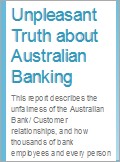Chapters 21 – 30
March 22, 2012
In the Appendix of the FEMAG Report headed Matters Beyond The Scope Of This Review, it notes: the constitution constrains the Code Compliance Monitoring Committee from making public statements on their own behalf other than in the Annual Report without prior approval of both the FOS and chairs of the bank CEOs association. This could […]
March 22, 2012
The FEMAG review expressed a view Compliance Monitors should be more proactive rather than reactive in making themselves available and accessible to stakeholders. To emphasise this, its report stated only a few stakeholders had any interaction with the Compliance Monitors and this interaction has been quite limited. Its October 2005 report provided recommendations for improved […]
March 22, 2012
In hindsight, it’s difficult to appreciate how the bank CEOs constitution might compromise aspirations of the Compliance Monitors in the early days. FEMAG was mindful of contradictions between the Code principles and the CEOs constitution however it seems neither the Compliance Monitors nor FEMAG anticipated problems undermining the Martin Committee’s high principles in 1991. These […]
March 22, 2012
Shortly after John McFarlane (ANZ) replaced David Murray (CBA), as Chair, and Gail Kelly (St George) replaced Ed O’Neal as Deputy Chair of the Bankers Association when it published the 2003 Code. The guard had changed and the restructuring period was underway, despite it being evident self-regulation relied on totally independent monitoring for effective enforcement […]
March 22, 2012
The Code is set out in six sections. The most important section for bank customers is Part B: Key Commitments and General Obligations. KEY COMMITMENTS AND GENERAL OBLIGATIONS Clause 2 sets out banks key commitments to customers and s 2.1 states what banks will do. It introduces three different cultures the banks must have wrestled […]
March 22, 2012
As suggested earlier, a get-out used by some, if not all Code subscribing banks is to confuse the words complaint and dispute. Glancing at the Code Compliance Monitoring Committee’s annual reports its evident few complaints are ever investigated by them. It seems the banks use their own interpretation of clause 40 to stonewall complainants. PART […]
March 22, 2012
Clause 10.3 in Code (2003) states ‘any written terms and conditions will include a statement by banks to the effect that relevant provisions of this Code apply to the banking service, but need not set out those provisions.’ On 16 October 2003, Ms Anna Dea, FOSs legal counsel, published a report titled ‘The New Code […]
March 22, 2012
Following the Martin Committee’s report, the government proposed banks design a Code of Banking Practice setting out ‘good banking practices’. To achieve this, the banks needed to include a dispute resolution procedure that was expedient, within the financial means of customers and, above all, fair. The 1993 Code was said to be a plainly worded document […]
March 22, 2012
Clause 5 of the Code sets out the commitment by subscribing banks to appoint an independent expert to review of the Code every three years. Clause 5.1 states: The subscribing banks will require the Australia Bankers Association to commission an independent and transparent review of the code every three years, or sooner if appropriate, with […]
March 22, 2012
During the past eight years, subscribing banks worked with parties they funded or had a relationship with to implement arrangements they could rely on to keep bad banking news for the public. An earlier chapter notes that ANZ published advice it was receiving 40,00 complaints per year, supporting a proposition one million complaints resulted in […]
- Introduction
- 1. CBA Sells, Won’t Pay Damages
- 2. Suncorp Bank and its Criminals
- 3. Suncorp McLoughlin and Crimes
- 4. Genner Predatory Westpac loan
- 5. Rabobank’s Directors Must Win
- 6. CBA’s Deceitful Code & Conduct
- 7. Bendigo Bank’s Worst Victim
- 9. NAB Predatory Lender or Bank?
- 10. Cheated by NSW Government
- 11. Australia is Bankster’s Paradise
- 12. CBA – Unconscionable Lender
- 13. Ruined by Com-bank Directors
- 15. Bendigo: a lender or fraudster?
- 16. Farmers Complain No Reply
- 17. Ruined by ANZ Bank
